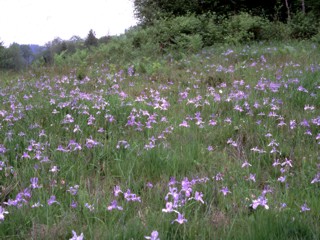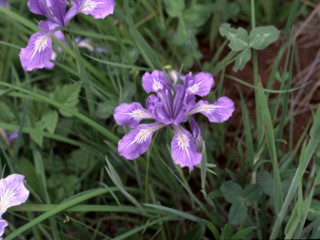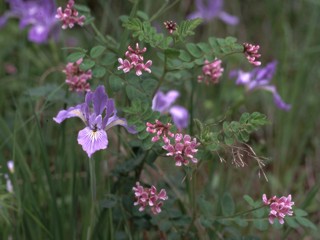- King County Iris Society
- Louisiana Irises: bright colors for boggy areas.
- Siberian Irises: gracefull foliage and a wide range of colors.
- Pacific Coast Irises: an amazing array of colors and patterns.
- Bearded Irises: colors and sytles to fit the needs of any gardener!
- Japanese Irises: magnificently majestic; eye-catching in the garden.
- Spuria Irises: tall and stately, ideal for landscape backgrounds.
- Species Irises: landscape marvels; genetic parents of modern hybrids.
For the past several years Debby Cole and I have been checking out locations of Iris tenax in the wild, in part, scouting for possible future field trips, but also trying to determine its preferred habitats and the boundaries of its range. In late May 2008, we made a circuit of the Willapa Hills. After leaving 1-5 at Chehalis, WA, we drove west on state highway 6 toward Raymond. Our timing was perfect, in spite of the very late season, and we saw iris not only along the highway, but also on some of the side roads that we explored, including the one to Rainbow Falls. We found the iris growing on dry, open roadsides and in the edges of open Douglas Fir forests. It springs up in clear-cuts within a very few years.
We saw no irises as we drove south from Raymond on highway 101. This area, though some distance from the actual coast, appears to get too much rain. Clear-cuts that appeared to be of the right age showed no sign of iris plants.
We drove inland up the Columbia River on Highway 4 until we were east of Cathlamet before the iris reappeared on the roadside cliffs. Side trips up the Gray's River and the Skamokowa River were unproductive--they were too wet, with too much farm-land. However, just beyond Cape Horn, on a side trip up Mill Creek Road and onto Spruce Creek Road we almost immediately found an outstanding patch of I. tenax in full bloom. It was growing on a south-facing slope which had been cleared some years back for a house that had never been built. The color range of the flowers ran from light orchid to medium red-violet, with orange streaks and white signals. Some flowers were up to four inches wide, with falls an inch across. I saw one white bud, and photographed a very nice double flower.
Iris were in bloom in many places along the network of back roads fanning out from Mill Creek Road, but further upriver, the roads leading back into the hills were unproductive--either the forests were too thick or there was too much farm land.
The following day we stopped to see Colin Rigby, off I-5 at Rochester. He took us on a series of secondary roads to the west of I-5, as far south as Ryderwood, where irises were in bloom along the road just outside the town. We also saw irises under power lines. On a north-facing clear-cut along King Hill road, the flowers were all quite pale.
We then made a loop east of I-5, going as far east as Mossyrock and Mayfield Lake on highway 12, where we were still seeing iris on the road cuts, but did not find out how much further east they go. We cut back to Centralia on the Centralia-Alpha road, still seeing many irises along the way. We walked in a short distance into one ten-year-old clear cut that was filled with clumps of I. tenax, mostly orchid in color, but some with a blue flash. The clear-cuts--in Douglas Fir forest--along this road varied considerably in age and would be good places to explore further and look for seed later in the summer.
On our final day, we investigated the Skookumchuck River northeast of Centralia, but the areas to which Hattie Hubbard had taken my husband and me many years ago were of course long grown up to forest. We saw iris at Bucoda, and at Tenino. We spotted a few flowers further to the northeast on King Road, but they ran out before we reached Yelm on the Nisqually Prairie. For reasons that remain a mystery, I. tenax does not occur on the Nisqually Prairie. It stops just north of Centralia, along I-5, but we do not know how far east it goes at the north end of its range. In Clark County, it extends into the Cascade foothills northeast of Vancouver, WA.
While we have not solved the problem of why great fields of Iris tenax can appear so quickly after a clear-cut (or, formerly, a fire), we do feel we now have a better idea of the ecological conditions in which it occurs. It seems to prefer the edges of drier, open conifer forests--it does not grow in damp, low places. It is not found with ash trees, nor in thick stands of big leaf maple. It likes south-facing slopes, but can grow on north slopes if they are dry and open enough. It is not limited to the red soil, which is rather intermittent in any case. It is widely distributed in Washington's seven southwestern counties, and does not seem to be in the least endangered within this area.
Whether I. tenax once grew further north than it does today, and was taken out by the Ice Age, is anybody's guess. It does not seem to mind our glacial soil in the Seattle area but it does like to grow out in full sun.

Field of Iris tenax
Willapa Hills, Spruce Creek Rd off State Rd 4

Double Iris tenax
Willapa Hills, Spruce Creek Rd off State Rd 4

Iris tenax and pink vetch
Willapa Hills, Spruce Creek Rd off State Rd 4